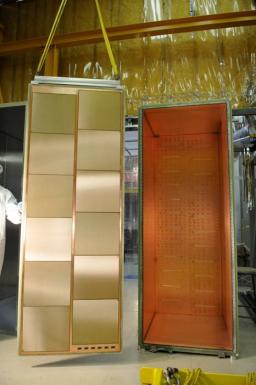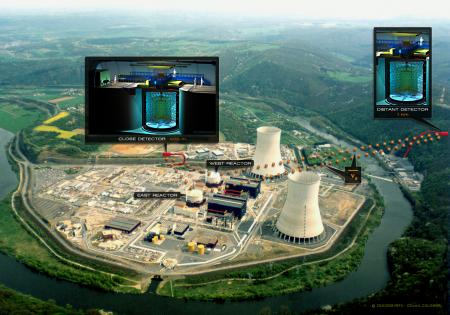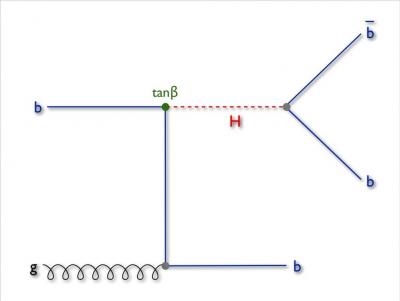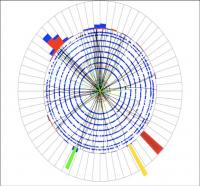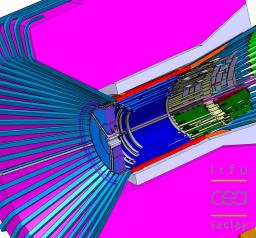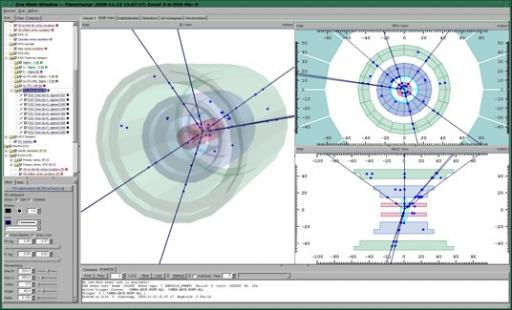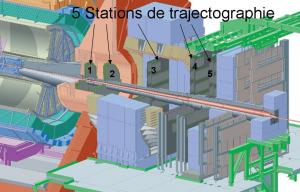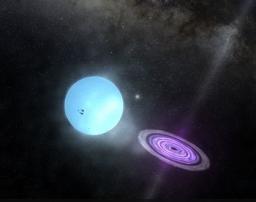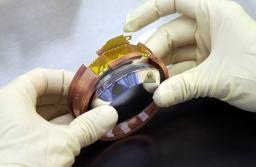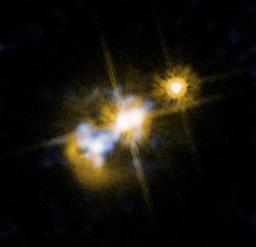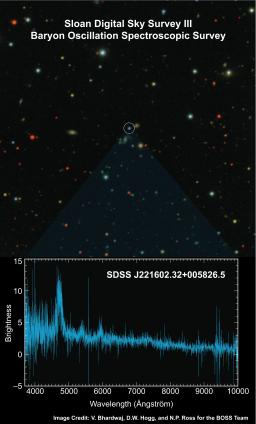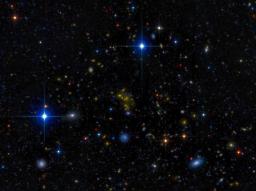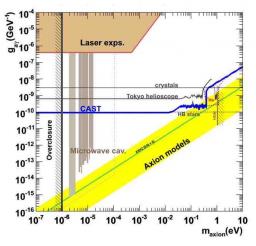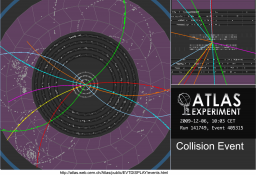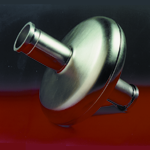Engineers and physicists from IRFU have successfully assembled and commissioned three large chambers designed to reconstruct charged particle tracks. The chambers will characterize the neutrino beam used in the T2K (Tokai to Kamiokande) experiment. They are the first large Time Projection Chambers (TPCs) to be equipped with micromesh gas detectors (Micromegas). The chambers have a very large sensitive area (nearly 9m²) and a correspondingly high number of electronic channels (124,000). IRFU built the entire detection system of the three TPCs, comprising 72 Micromegas detectors and all the front-end electronics. Engineers from SEDI, a department specialised in detector, electronics and information technology, specially designed a new chip called AFTER and two printed circuit boards for sending digitised signals to the acquisition system via an array of 72 gigabit optical links. The three chambers were tested with a particle beam at TRIUMF in Canada and have been installed in JPARC (Tokai, Japan) at the end of 2009.
The first beam and cosmic ray tests demonstrated that tracks could be reconstructed with the required degree of precision. This achievement represents a major step forward in the construction of a vital detector for the T2K experiment.
The TPC are now detecting tracks produced by neutrino interaction in the near detector of T2K and provide superior information to measure the momentum and to identify these particles.
Contacts:
The second phase of the Double Chooz international experiment officially began on Wednesday 20 May. The Declaration of Intent signed by the four partners (CEA, CNRS, EDF, Champagne-Ardenne Region) is the first step in the plan to build a second detector devoted to neutrino research next to the Chooz nuclear power plant. Prior to signing the DOI, the participants visited the site of the first detector, currently under construction. By the end of the year, the detector should pick up the first neutrinos emitted by the plant and attempt to measure the disappearance of primary flux neutrinos. The second detector, which will be operational two years from now, will provide precise measurements of the flux and spectrum of the neutrinos emitted and greatly enhance measurement control and precision. Contact
Since researchers have been confronting the standard model of particle physics with experimentation, nothing has been able to shake it. Of all particles it describes, only the Higgs Boson has not yet been discovered. But the standard model is probably not the ultimate theory: it does not cover gravitation and numerous experimental observations remain unexplained.
A new invariance, called supersymmetry, was suggested during the 1970s. It associates particles with different spins (integer spin bosons and half-integer spin fermions). It is possible to create supersymmetric extensions of the standard model, elegantly resolving the mathematical problems that emerge during calculation of the Higgs Boson mass.
D01 experiment accumulating data from Fermilab's Tevatron (United States) just published2 results relating to the Higgs Boson research needed for supersymmetric extensions to the standard model. All currently available data has been analysed, representing more than one and a half billion events.
Finding a supersymmetric light Higgs
In the Tevatron, a high-energy proton-antiproton collider, large quantities of Higgs Bosons could be produced if they are sufficiently light. A useful channel for detecting them is their production associated with a bottom quark3 (b), H0b. In 90% of cases, supersymmetric light Higgs Bosons are supposed to disintegrate into two bottom quarks. That is why research in this area is based on identifying those events involving at least three jets4 resulting from bottom quarks in the final state.
Until the advent of the LHC, the Tevatron at the Fermi National Accelerator Laboratory, Fermilab (close to Chicago, USA), will remain the world's most powerful collider and the only location where the top1 quark can be produced.
The DØ experiment recently published2 results on the measurement of the rate of production of top-antitop quark pairs. This quantity, which is dependent on the value taken for the mass of the top quark, enables a prediction to be made for that mass using the standard model3. The top quark, which was discovered at Fermilab in 1995, remains the subject of very active research. Methods of analysis and the quantity of data are forever improving, which is resulting in subsequent improvements in the accuracy of the measurement of the top quark mass. The precise measurement of this value, combined with results from other precision measurements, enables the most probable mass of the Higgs Boson to be estimated. Hence improved measurements of the mass of the top quark is tightening the vice in the search for the Higgs boson.
Monday, 23 November 2009, marked the first particle beam collision inside the large detectors of the LHC. ALICE saw its first collisions at an energy of 900 GeV, enabling it to check for correct operation of the 18 large detectors which comprise it. Since 27 November, with just a few days worth of data, the collaboration has even published an article confirming some existing measurements. The group from the IRFU, who are responsible for the dimuon arms, had to await more stable beam conditions in order to see their detectors reacting to the data coming from the collisions and, on 6 December, all the gaseous detectors were able to be powered up. The traces from the first muons could be successfully reconstructed, to the great satisfaction to all the team. They are now eager to begin collecting more data after the planned restart in February 2010.
At the end of March 2009, the ALICE Muon Spectrometer took cosmic rays over a period of two weeks. The ALICE group at Saclay2 was closely involved in the design, development, construction and installation of a part of the chambers of this Spectrometer3. The purpose of the cosmic ray test was to check the performance of the entire system, from acquisition to reconstruction of the data. The acquisition system readout about a million channels and the data was recorded on the computing grid. Almost 15,000 tracks were reconstructed under conditions close to those of the real experiment. The cosmic test was a success, demonstrating the performance and the stability of the spectrometer chambers. It also revealed some weak points of the system. Tests are currently underway to correct the observed defaults.
Another cosmic test is planned for August, a few weeks before the first LHC beam injections, involving all ALICE detectors.
Contacts:
For the first time, the high-energy gamma rays emitted by a microquasar have been spotted with certainty, thanks to NASA's Fermi telescope. The observation of the microquasar Cygnus X-3 by a French team (CEA-IRFU, CNRS-INSU and IN2P3, University of Paris Diderot, Joseph Fourier University) teaches us more about how these particular sources function and how a compact object orbiting a star can hurl a mass equivalent to the Moon's through the interstellar medium at almost the speed of light. The study is published in Science Express on 26 November 2009.
- for more information : see the French version
The new generation of detectors from the Edelweiss experiment, which is searching for dark matter, have just delivered their first results. Remarkably reliable and robust, they have proved excellent at removing interference signals. Although only just installed and not yet perfected, these new detectors have improved the experiment's sensitivity by a factor of 10 in terms of its capacity to measure an interaction with a "wimp"1 , a weakly interacting massive particle, which is one of the candidates for dark matter.
Article submitted to Phys Lett. B (online)
In 2010 the usable mass of detectors will be tripled in order to improve their discovery potential still further.
This jump in sensitivity puts this experiment in amongst the leading group of experiments worldwide that are seeking to detect these new particles. These first results have just been submitted for publication in the journal Physics Letters B
Which came first - the black hole or the galaxy? Many large galaxies in the Universe have a supermassive black hole at their centre. But which came first? The black hole that is frantically consuming the matter around it or the vast galaxy that is its home?
A European team led by David Elbaz from CEA-IRFU's Astrophysics Department has just discovered a spectacular interaction between a quasar and a galaxy from observations made with the VISIR camera. The camera was built at CEA-IRFU and installed on the European Southern Observatory's (ESO) Very Large Telescope in Chile. A jet from the quasar is responsible for star formation on a large scale in the galaxy (see animated view). From these observations, a new scenario seems to be emerging: black holes might "build" the galaxy that will become their home. This surprising discovery is published in the journal Astronomy & Astrophysics on 30 November 2009.
The Baryon Oscillation Spectroscopic Survey - known as Boss - delivered its first data during the night of 14-15 September. This experiment, devoted to the search for baryon oscillations, heralds the start of a new era of research into dark energy and the evolution of the Universe. Several teams are involved in BOSS, in particular from IN2P3(1)/CNRS, INSU(2)/CNRS and CEA.
The Supernova Legacy Survey (SNLS) team at the Canada-France-Hawaii Telescope facility has just obtained the world's best measurement of the explosion rate of massive stars when the Universe was only 10 billion years old. A research team at IRFU's particle physics department at the CEA-Saclay centre worked on the first three years of SNLS data to obtain this result, which makes a crucial contribution to our understanding of the origins and evolution of chemical elements in the interstellar medium. The measurement seems to show that there are two to four times fewer supernovae today than 3.7 billion years ago. Could the Universe be burning out?
Contacts:
Nathalie PALANQUE-DELABROUILLE
The Nobel Prize for Physics 2008 rewarded Makoto Kobayashi and Toshihide Maskawa for having realised that the weak interaction does not affect particles and antiparticles in the same way1. In this theory, it was expected that the strong interaction would exhibit the same type of asymmetry between quarks and antiquarks.
However the asymmetry is not there! A problem! To explain this anomaly of the strong interaction, theoreticians have postulated the existence of a new particle known as the "axion", named after a detergent because it will help to clean up the problem. Expected to be both neutral and light, this particle will be analogous to a photon, with which it could be coupled. On the other hand it will only interact slightly with matter, so slightly that, to date, it has never been observed.
CAST2 is an experiment designed to detect this hypothetical particle which may be produced abundantly by the sun. The collaboration recently published their results ("Journal of Cosmology and Astroparticle Physics") which have enabled the limits of the predicted mass of the axion to be reduced.
The search for axions continues, thanks to improvement in the performance of the CAST Micromegas detectors, enabling the level of noise to be reduced to an extremely low level, in the low energy regime between 1 and 10 keV, and so to further reduce the lower limit for detection of these hypothetical particles.
Why are we interested in axions?
Axions are particles which were introduced by theoreticians to explain the apparent symmetry between matter and antimatter in the strong interaction. These axions, neutral and of very low mass, are also candidates to make up the dark matter in our universe. Theoretical models and astrophysical observations limit the mass of the axion to being in the range between several µeV/c2 and several eV/c2.
The absence of observation of axions in the CAST experiment has enabled an experimental upper limit to be established for the axion-photon coupling constant, for masses less than 0.4 eV/c2 (figure 1). For the first time this limit has reached the yellow band favoured by the theoretical models.
Since the restart of the LHC on 20 November, CMS has taken advantage of the excellent operating performance of the collider to record a large amount of useful data. This is now being used to check its correct operation and calibration. During this period, CMS has demonstrated the stability of the detectors' working conditions as well as the efficiency of the data analysis system, which sends data from the detector to analysis teams around the world, and this in spite of very rapidly changing beam conditions.
Since the accident which occurred on the LHC accelerator several days after its commissioning in 2008, the ATLAS collaboration has been impatient to observe "true" events produced at the centre of the detector, and to make the equipment function under real conditions. On 23 November, following several days of tests with a single beam, Atlas recorded its first proton-proton collisions, at the injection energy into the LHC (450 GeV per beam, i.e. 900 GeV in the centre of mass reference frame of the collision). Analysis has then been able to reconstruct known unstable particles by detecting their disintegration products, demonstrating that the detectors and associated software are functioning correctly. The Atlas group, from the Particle Physics Department at IRFU, has also been able to check the behaviour of the muon detector sub-systems and the electromagnetic calorimetry, for which it is responsible. Collisions at 2.38 TeV (1.19 TeV per beam) were recorded before the LHC shutdown on 16 December, establishing a new world-record as of the most powerful particle accelerator in the world. The LHC will start up again in February 2010 after a short technical break aiming to produce collisions with higher energies and at higher intensity. Dark matter may be made of new particles, which could be produced in the high-energy proton-proton collisions at LHC. In this case Atlas would be able to discover them.
For more than 20 years, solid niobium has had the monopoly on high-gradient applications of superconducting radio frequency (SRF) cavities for particle accelerators. But it will soon have reached its limits. It was only recently that A. Gurevich, a theoretician from Florida State University, put forward a theory explaining the reasons behind niobium's success and a way of breaking its monopoly. Until now, this theoretical model had never been experimentally demonstrated. This has now changed for a collaborative project between IRFU (Saclay) and INAC (Grenoble) has just made this vital step towards new acceleration technology.
Work on a new clean room, begun in July 2007 at the Saclay accelerator platform, has just been completed. The new clean room will be officially opened on 24 November 2009 and will replace the chemical facilities and clean room of IRFU's Accelerators, Cryogenics and Magnetism Division (SACM) located at L'Orme, which could no longer undergo all the improvements required to keep pace with current development work. A hall in building 124 (previously the Saturne laboratory) has therefore been renovated to accommodate the future facilities and equipment compatible with future accelerator research requirements and collaborative projects with industrial partners interested in the control of superconducting cavity systems.

